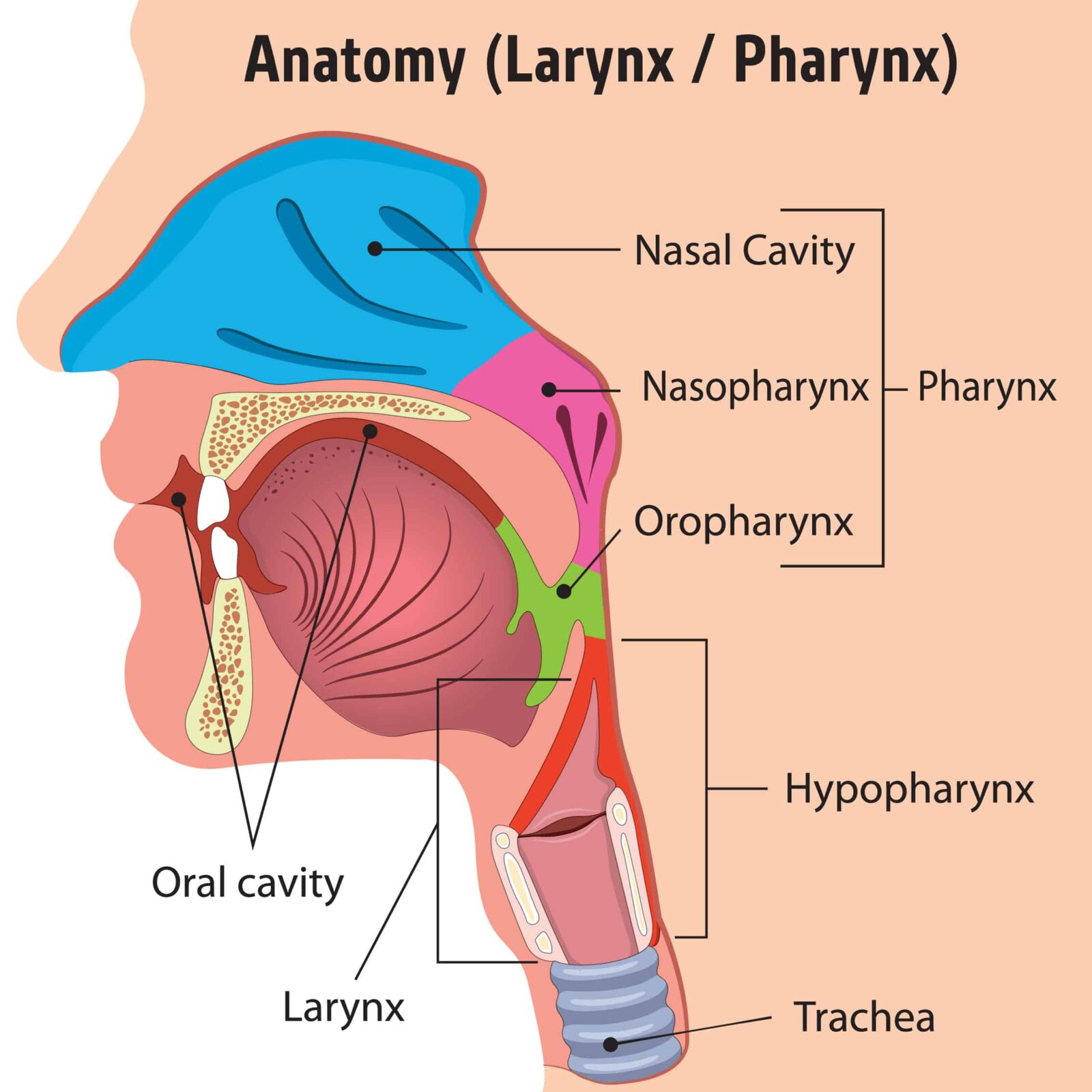
What Is LPR? What Is the Pharynx?
At-A-Glance
- LPR (laryngopharyngeal reflux) is acid reflux that comes up into the larynx (voice box) and pharynx (throat). I coined the term in 1987 to distinguish what I was seeing in my patients with voice, throat, and respiratory problems from GI patients with heartburn and esophageal disease (GERD).
- Respiratory Reflux (coined in 2017) is a simpler, more intuitive term; it’s synonymous with LPR. And as should be implied, respiratory reflux can affect any part of the respiratory system. With that being said, when it comes to reflux, the pharynx is a critical crossroads, because that’s where the respiratory and digestive tracts share space, intersect, and collide.
- The Pharynx extends from the nasal cavity at the base of the skull to the trachea (windpipe) and esophagus (swallowing tube) where they enter the chest (below). Pharyngeal reflux can cause a wide array of problems, including ear stuffiness, pain, popping, hearing loss, tinnitus, big uvula, snoring, sleep apnea, post-nasal drip, sinusitis, laryngitis, swallowing problems, asthma, chronic cough, bronchitis, gum and dental disease … just to mention a few.

When most people think of the throat, they point at the neck area at the level of the voice box. However, the pharynx is a big, complex, and crucially important anatomic region that extends from the skull base (behind and above nasal cavity) to the hypopharynx, where it joins the trachea (windpipe) and esophagus (swallowing tube) that both then enter the chest.
What makes the pharynx so important is that it is part of the digestive and respiratory tracts, BOTH! You eat, swallow, and breathe there. That’s where “everything”― air breathed, everything swallowed, and even backflow, reflux ― crosses paths, often with untoward consequences.
The hypopharynx is also called the laryngopharynx, because that’s where the airway splits from the digestive tract. Indeed, the hypopharynx is the Grand Central Station of the aerodigestive tract (respiratory and digestive tracts together as one entity). Acid reflux can get into any part of the pharynx, and the anatomic subdivisions shown in the diagram help explain the protean manifestations of LPR, that is, all the different kinds of reflux symptoms.
Can Acid Reflux Cause Ear Symptoms Like Hearing Loss and Tinnitus?
Nasopharynx: The working ends of the eustachian tubes ― that frequently open to equilibrate air pressure in your ears ― are located in the nasopharynx. Do you know when you swallow, you hear clicks in both ears? Well, those clicks are the eustachian tubes opening; they are pulled open during every swallow by a sling of palatal and pharyngeal muscles.
Reflux around the eustachian tube areas (especially silent nighttime reflux) causes swelling and inflammation, making the eustachian tubes less likely to open, leading to symptoms, including abnormal pressure, discomfort, and even pain in one or both ears, as well as hearing loss and tinnitus (ringing in ears). Yes reflux, respiratory reflux (LPR) can cause all of those ear symptoms, and commonly does.
Can Acid Reflux Cause Enlarged Uvula, Snoring and Sleep Apnea?
Oropharynx: The oropharynx is just below the nasopharynx, at the level of the palate and uvula (the tear-dropped-shaped tissue that hangs down when you look in the mouth). Reflux can cause the uvula to become so large that it hangs on the back of the tongue, even on to the larynx. An enlarged uvula can be very annoying! Today, there are a lots of ENT doctors doing lots of unnecessary uvula and palate surgery for this. A better treatment is to stop the reflux, because with time, the uvula will naturally shrink back to its normal, no-more-symptoms size.
Did I mention the palate? Oh yes, I did. When it is so swollen that the oropharynx is narrowed, snoring, sometimes loud, “whole house” snoring can result. Normally, the oropharynx is wide, “golf-ball-sized” open, but if you have silent reflux for years or decades, this opening becomes very much smaller (marble-sized, and circumferential throat tissue become swollen and stiff; this can cause snoring and sleep apnea. And again, a lot of unnecessary surgery (a procedure called UPPP) is being performed for this, when long-term reflux treatment consisting of healthy diet and lifestyle might be a better remedy for the problem.
Can Reflux Affect the Mouth, Gums, and Teeth?
While not part of the pharynx, the oral cavity (mouth) is obviously directly connected; LPR should be considered in any adult with rapidly progressive gum and dental disease.
Can Reflux Affect Voice, Swallowing, Airways, and Lungs?
Hypopharynx aka Laryngopharynx: The hypopharynx is just below the oropharynx, at the level of the larynx (voice box). Basically, it is at the bottom of the pharynx where the pharynx joins the trachea and esophagus; here is the exact spot where the respiratory and digestive tracts diverge. The vocal cords themselves are supposed to provide a (tight) valve function keeping both that which is going down (consumed) and that which comes up (reflux) from entering the tracheobronchial tree (large airways) and lungs. When the larynx (i.e., vocal cords) fails this gatekeeper function, aspiration can occur.
LPR is associated with voice changes and voice symptoms including hoarseness, vocal fatigue and effortful speaking. In most cases of LPR, the nighttime reflux pools on the vocal cords, and the subsequent swelling and stiffness causes the voice symptoms. See also Singers: How to Save Your Voices. Anything refluxed that travels south of the vocal cords is big trouble. ALL respiratory (lung) diseases may be caused, or worsened by LPR including Asthma, Chronic Cough, Bronchitis, and COPD.
The vocal cords form the glottic valve, which is one of the two important valves in the hypopharynx. The second important valve is the UES or upper esophageal sphincter. The hypopharynx funnels into the UES and esophagus, and the UES is supposed to open to let food through (into the esophagus) with swallows, and act as a barrier ― the last line of defense ― to the backflow, reflux, of food, acid, pepsin, etc. from the stomach.
The misbehavior of the UES is crucial to reflux as well as globus (a lump-in-the-throat sensation) and dysphagia (difficulty swallowing). Paradoxically, the most common cause of UES malfunction is reflux. As the UES valve gets inflamed and swollen, it stops working normally so that the more you reflux, the more you reflux. (A blog on globus and dysphagia is coming.) Suffice it to say that UES trouble caused by reflux is part and parcel of LPR. Thankfully, UES mischief and misbehavior (symptoms) are almost always completely reversed with a strong anti-reflux protocol, the over-arching focus of this website.










